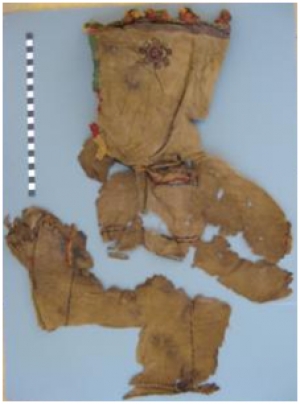Numerous textiles were excavated at the site, from both the settlement itself and from the nearby cemetery. According to the excavators, all the textiles from the cemetery were plain, except for a few pieces of embroidery of varying sizes and conditions. The embroidered fragments, apart from some smaller pieces discussed elsewhere, belonged to a hooded child's tunic. This garment has been dated to the fourth century AD. The fragments of the garment were recorded from Grave 272 and found in association with a newborn baby. The size of the garment would indicate it had been made for a young child; it was far too large for a baby. The tunic was originally made from another, probably an adult’s garment. The remains of the garment were given the record number 31/420-C5-2/272.
The garment was made from a weft-faced tabby cloth in wool. The body of the garment was decorated with embroidered lines (clavi), worked in a simple couched thread using blue-green, purple, red and yellow woollen yarns. The purple wool was used for the long lines going from the shoulder to the hem. The other stripes were of graduating lengths; these were worked in blue-green, red and yellow woollen yarns. There were similar stripes on the sleeves of the garment.
The main decorative area is on the hood. On either side, in the middle, there is an orbiculus made of three concentric rings worked in purple wool using stem stitch. The innermost ring is divided into four and filled in with satin stitch in pink wool. This has a wave border worked around it in double running stitch. The front edges of the hood are decorated with blocks of blue-green, orange, red, blue-green and yellow worked in blanket stitch. In addition, the top of the hood is decorated with five pompoms in multi-coloured woollen yarns.

Sources:
- LIVINGSTONE, Rosanne (2012). ‘Five Roman-period tunics from Kellis,’ in: Roger S. Bagnall, Paola Davoli and Colin A. Hope (eds.) , The Oasis Papers 6: Proceedings of the Sixth International Conference of the Dakhleh Oasis Project, Oxford: Oxbow books.
- VOGELSANG-EASTWOOD, Gillian (2016). 'Late Classical and early medieval embrodieries from Egypt and Nubia,' in: Gillian Vogelsang-Eastwood (ed.), Encyclopedia of Embroidery from the Arab World, Bloomsbury Academic, pp. 58-70, esp. pp. 61-64.
- http://arts.monash.edu.au/archaeology/excavations/dakhleh/ismant-el-kharab/ismant-texts-textiles.php (retrieved 16 February 2013).
GVE and RL

